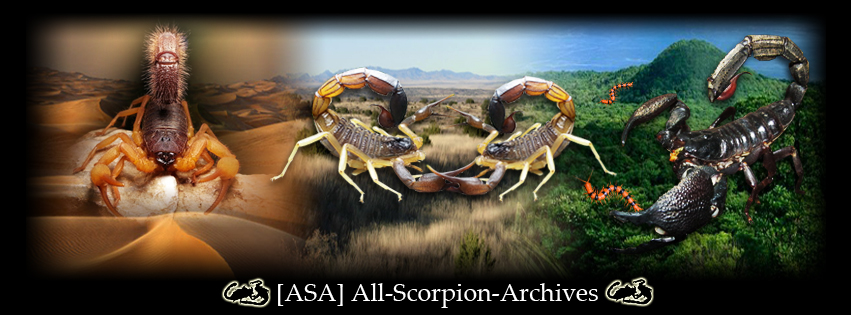P. transvaalicus and A. bicolor look rather similar
3 posters
Page 1 of 1
 P. transvaalicus and A. bicolor look rather similar
P. transvaalicus and A. bicolor look rather similar
Hello everyone
I'm having trouble differentiating P. transvaalicus and A. bicolor.
I havent had a bicolor and I dont know the physical differences in their morphology.
Although there is a size difference between the two, how else can i tell one from the other? They're both black/brown and have fat tails.
Thank you
*edit*
Looking at the two, i can see that the telson of the bicolor is smaller relative to body size. Please correct me if i'm wrong.
But how do you know which is which if the scorpion shown in a picture is young?
Like in P. transvaalicus, the fatness of the tail is first seen at 3i.
In that case, for example i might be looking at a small scorp with a fat tail which could either be a 3i> transvaalicus or an older bicolor (coz they are smaller).
I'm still an amateur which is why i just want to learn.
Thanks again!
I'm having trouble differentiating P. transvaalicus and A. bicolor.
I havent had a bicolor and I dont know the physical differences in their morphology.
Although there is a size difference between the two, how else can i tell one from the other? They're both black/brown and have fat tails.
Thank you
*edit*
Looking at the two, i can see that the telson of the bicolor is smaller relative to body size. Please correct me if i'm wrong.
But how do you know which is which if the scorpion shown in a picture is young?
Like in P. transvaalicus, the fatness of the tail is first seen at 3i.
In that case, for example i might be looking at a small scorp with a fat tail which could either be a 3i> transvaalicus or an older bicolor (coz they are smaller).
I'm still an amateur which is why i just want to learn.
Thanks again!

lazydonut- Spermatophore
- Posts : 40
Join date : 2014-03-23
Age : 29
Location : Manila, PH
 Re: P. transvaalicus and A. bicolor look rather similar
Re: P. transvaalicus and A. bicolor look rather similar
I thought (but I'm not sure about this) that it had something to do with the amount of granulation on the metasoma..
Parabuthus- Spermatophore
- Posts : 13
Join date : 2014-05-21
Age : 29
 Re: P. transvaalicus and A. bicolor look rather similar
Re: P. transvaalicus and A. bicolor look rather similar
Like Parabuthus said, looking at the metasoma is the best way of differentiating between the two. P.transvaalicus has much more granulation on the metasoma as well as having setae where as A.bicolor has none. The telson as you said is also smaller on A.bicolor than P.transvaalicus relative to their metasoma size.
Of course there are a lot of other smaller differences between them but looking at the metasoma is the easiest way.
With lower instars the differences are still there it's just more difficult to see.
Of course there are a lot of other smaller differences between them but looking at the metasoma is the easiest way.
With lower instars the differences are still there it's just more difficult to see.

Shadowfoot- Scorpion breeder
- Posts : 191
Join date : 2013-01-31
Age : 32
Location : South Africa
 Re: P. transvaalicus and A. bicolor look rather similar
Re: P. transvaalicus and A. bicolor look rather similar
Thanks. I see the granulation lacks in the spaces between the longitudinal metasomal granulations in A. bicolor whereas the other has carinae all over the place.
Oh and I'd like to add what I've learned, younger instars of A. bicolor is a light yellow to brown, darkens with age, but P. transvaalicus turn almost black at 2nd instar.
Oh and I'd like to add what I've learned, younger instars of A. bicolor is a light yellow to brown, darkens with age, but P. transvaalicus turn almost black at 2nd instar.

lazydonut- Spermatophore
- Posts : 40
Join date : 2014-03-23
Age : 29
Location : Manila, PH
Page 1 of 1
Permissions in this forum:
You cannot reply to topics in this forum